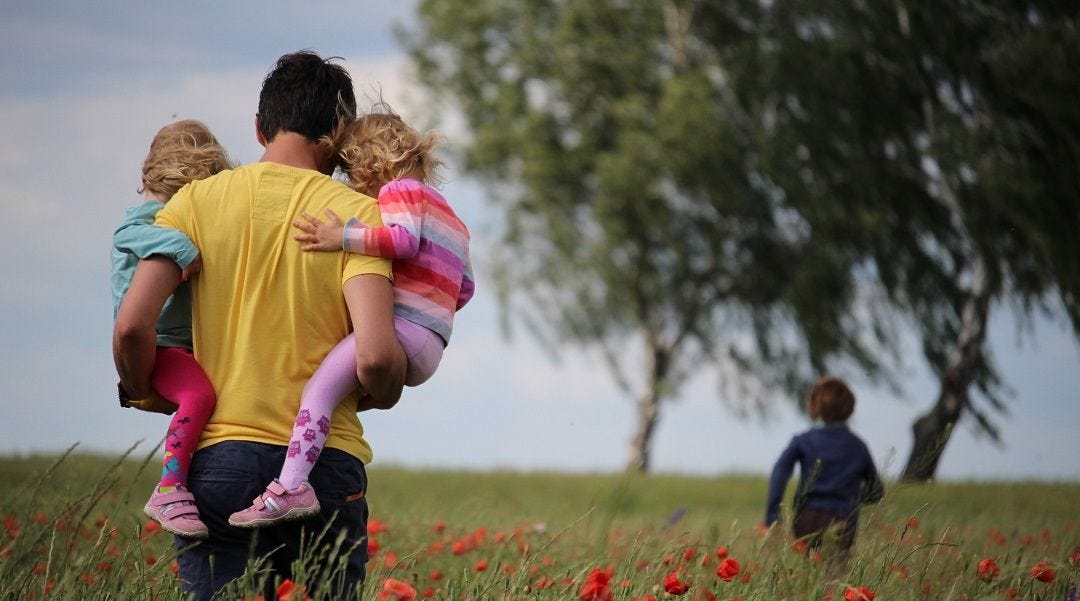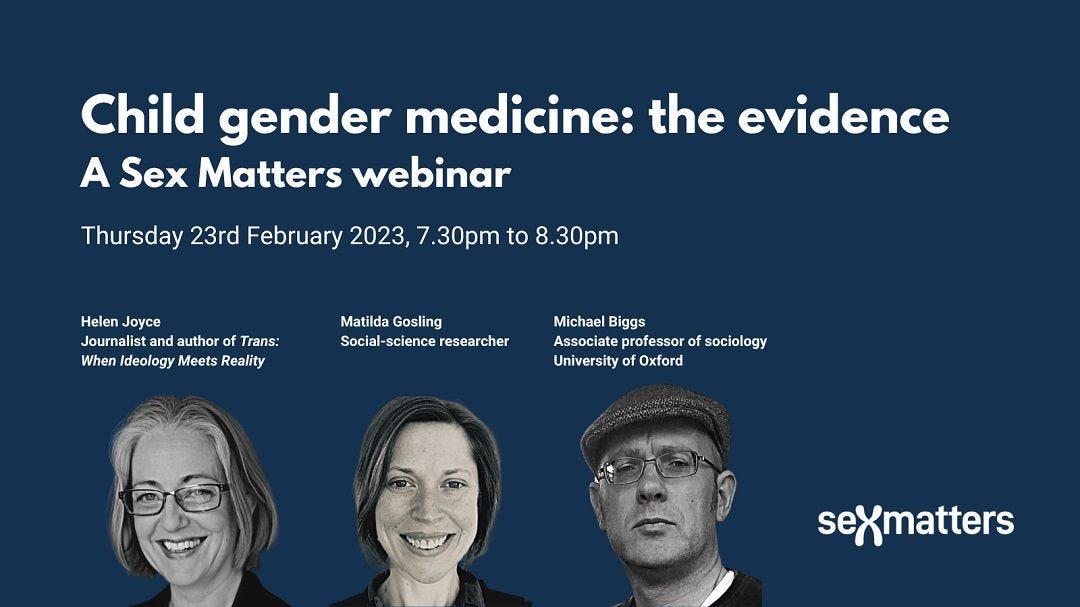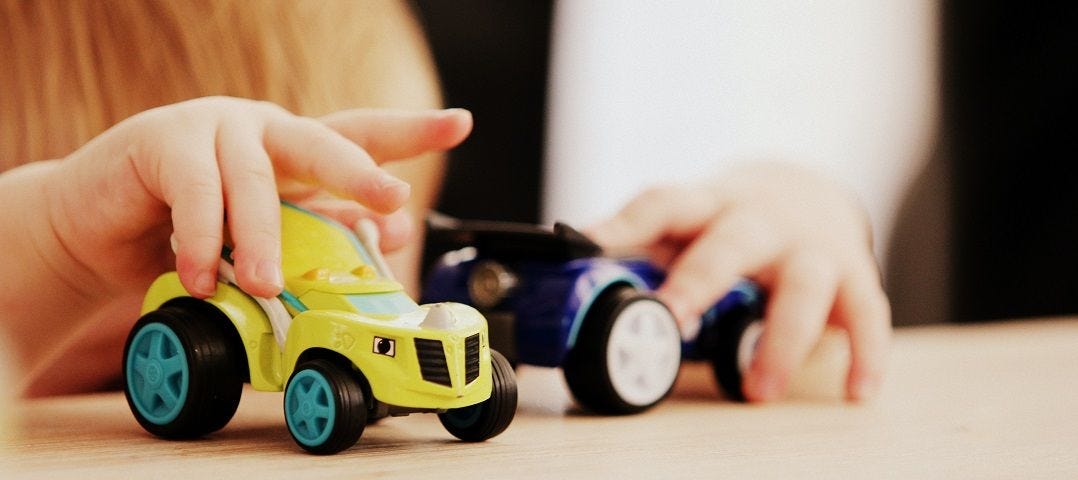Afraid to say No
Self-centred, virtue-signalling, emotionally incontinent adults who fail to hold boundaries are letting down children
Apologies for missing a week: I had a computer meltdown (caused entirely by my own stupidity, and now resolved).
I thought this week I’d share some reflections inspired by the talk I gave a few weeks ago at “Sexual Identities in Transit: A Contemporary Question”, a one-day conference in London of the New Lacanian School of psychotherapy. As I said in a previous issue, the event was significant for being the first I know of aimed at professionals who work with gender-dysphoric or trans-identified people that sought to platform gender-critical voices. I think there was pressure in the run-up both to cancel the event outright and to get University College London to cancel the room booking. But the deplatformers got nowhere, adding weight to my theory that when people find their spines, the bullies slink off in search of an easier target.
f you are not a subscriber to my weekly newsletter, you might like to sign up for free updates. I hope that in the future you might consider subscribing.
As the first speaker of the day, I had been asked to give an overview of how paediatric gender medicine had arrived at its current state. I was followed by Michael Biggs, an Oxford sociologist who has done a great deal to reveal the poor quality of research and care at GIDS, the paediatric gender service at the Tavistock clinic in London; Marcus and Sue Evans, both of whom used to work at the Tavistock and left as whistle blowers; and David Bell, a psychiatrist and psychoanalyst who acted as a staff governor at the Tavistock and wrote a highly critical report about GIDS.
(As it happens, I recently moderated a webinar with Michael Biggs and Matilda Gosling, a social-science researcher, on what the evidence says regarding paediatric gender medicine, which can be watched back on YouTube.)
Between us we took up most of the morning; the afternoon, which I didn’t attend, was devoted to discussion among the therapists. But before the morning session closed a member of the audience stood and expressed disgust and anger at our alleged transphobia and lack of respect for trans identities. He drew an analogy between our words and arguments, and those of the psychological professionals from the 1950s onwards who sought to “cure” gay people with aversive treatment aimed at making them associate same-sex attraction with pain and feelings of disgust—so-called “conversion therapy”. We had made him feel unsafe and worse, he said—clearly sincerely; his voice and body were shaking as he spoke.
I suppose I’m glad he came to the event rather than parroting “no debate” and staying away. (Although, I suppose, he may not have realised what he was letting himself in for. One of the organisers told me afterwards that he wasn’t a member of the society. He might have seen the event listed on Eventbrite and misinterpreted the, admittedly ambiguous, title.)
But overall it struck me as typical of a toxic, entitled type of performative emoting that increasingly displaces genuine empathy. This man was telling us how what we said affected him—and frankly, I couldn’t care less. The question of how gender-distressed children are treated is about the children’s safety, health and well-being, not about how that treatment makes the grownups around them feel. And this sort of self-centredness and emotional incontinence is a big part of why these children are being harmed.
Too many adults are allowing their emotional reactions—of self-satisfaction at their own virtue-signalling; of the pleasure and relief of giving people what they want in the short term while avoiding the discomfort of saying no—to shape the decisions they make for children. And while they are steeped in whipped-up emotion, they are failing to engage their brains. That’s how bad analogies pass unchallenged, like the one between the dire history of anti-gay “conversion therapy” and supporting today’s gender-distressed children with counselling rather than drugs and surgeries. As gender-critical voices gain strength, the grownups in many, many rooms are going to have to remain calm and reasonable as our opponents resort to crybullying. Too many people are too heavily invested in the gender-identity narrative for de-escalation; the only out now is through.
Well, here’s an extended and tidied-up version of what I said relating to the history of paediatric gender medicine (I also discussed the more recent social contagion among teenage girls). You can judge for yourself whether it merited condemnation.
The idea that one is, in some sense, “really” of opposite sex has, I believe, arisen spontaneously in rare individuals in different places and times. This happens for more than one reason—and what comes next depends on the surrounding culture.
One of those reasons is nascent homosexuality. Richard Green’s book “The Sissy Boy Syndrome and the Development of Homosexuality” was the first study of little boys who were ardently convinced that they were meant to be girls, or indeed really were girls. Every study of such children—both boys and girls—has found the same thing (provided those children’s beliefs are not reinforced by the adults around them): most grow out of this belief before or during puberty, and most grow up to be gay.
Why do children come to think that they were “meant to be” members of the opposite sex? The evidence—and this was already known by the early 2000s—is that gender dysphoria follows from and is created by innate gender non-conformity. We have plenty of evidence that gay people, as little children, are often highly unusual for their sex. Some children who are strikingly at variance with the norm for their sex interpret that as meaning that they really are not of that sex, because of the meaning attributed to gender non-conformity in their culture, and because of specifics of their personal situation.
In one culture a little boy like this will be seen by those around him as a proto-fa’afafine, which means “in the manner of a woman”. This traditional Samoan category consists of male people who are understood to be male, but not men—in part because traditional Samoan culture has no room in “manhood” for men who sleep with men. Across the West, until recently at least, the same boy would have been understood as likely to grow up gay. But now, increasingly, he’s at risk of being interpreted as a “trans kid”, and having social transition suggest-sold to him, whether by his parents, teachers or social media.
But that doesn’t explain the difference between one little proto-gay child in today’s trans-addled Western culture who notices that they are unusual for their sex but doesn’t interpret that as meaning they are really a member of the opposite sex, and another child in the same culture who develops gender dysphoria and decides they are trans. It’s never easy to feel very different from other people. Why does one child make it to adolescence without dissociating from their sex, while the other doesn’t? I think it’s a mistake to say it’s all down to whether the child’s community and family are homophobic or accepting, although of course that does play a role.
From talking to parents and observing such children, I have concluded that two bits of happenstance make a big difference in which of these roads a particular child goes down. The first is whether they have siblings who strongly conform to their sex’s stereotypes. The second is whether the parent of the same sex presents an achievable and reasonably congenial vision of adulthood.
Take a little boy of the sort Richard Green wrote about: one who prefers dolls, princess dress-up, high heels and makeup to toy trucks, rugby and wrestling. The more “props” there are in his environment with which he can perform his preferences, the more likely he is to behave in ways that raise questions in other people’s minds—and in his own. And that’s a question of whether his mother likes makeup, party dresses and heels, and whether he has any sisters who like dolls and dress-up. Without such props to hand, he won’t find it easy to discover, let alone express these innate interests, and less likely to draw other people’s and his own attention to what makes him so different from other boys.
The same is to some extent true for a “tomboy” girl, but moderated by greater social acceptance of tomboys as compared with “sissies”. (Green’s book title wasn’t intended to be negative about these boys, by the way, but to draw attention to how uncomfortable their parents and society at large were with “effeminacy”.) Nowadays, however, these are precisely the girls most at risk of having other people interpret them as “trans boys”.
With parents, and perhaps older same-sex siblings, the question is whether the version of that sex they present is one that the child can imagine inhabiting. This isn’t necessarily about being gender non-conforming.
A “sissy boy” whose father is mad about, say, boxing, hunting and lads’ nights out will find the idea of growing into manhood much harder than one whose father likes chess, computer games and gardening. Plenty of ordinarily heterosexual men are more like the latter than the former, and growing up to be like such a dad will be much easier to imagine for a gender non-conforming son.
Similarly, a rough-and-tumble girl whose mother lives to shop, get her nails done and host garden parties will find womanhood much less habitable than one whose mother is an academic who lives in jeans and trainers and goes rock-climbing at weekends.
I started by saying that there was more than one reason a person might spontaneously land on the notion that they are “really” a member of the opposite sex. The second reason I’ll highlight is the male sexuality labelled “autogynephilia” by Ray Blanchard, in which the primary attraction is towards the image of oneself as a woman.
What this man wants is the reality of being a woman; he will not be satisfied by a simulacrum, and he can’t be merely humoured. This makes it a difficult sexuality—not just for the man himself, since what is desired is by definition unachievable, but for other people, since they are required to play along. This sexuality includes within it a prohibition on honesty. In the words of science historian Alice Dreger, the author of “Galileo’s Middle Finger”, autogynephilia is “best understood as a love that would really rather we didn’t speak its name”.
Blanchard’s central insight was that what had been thought about as “transvestism” is really about the feminine persona. The more feelings about that persona are focused on the clothes, the more likely it is the man can be satisfied by merely cross-dressing; the more they’re focused on the body, in particular the genitals, the more likely it is that he will want cross-sex hormones and genital surgery.
The erotic disruption caused by speaking about autogynephilia goes a long way towards explaining the ferocity with which its existence is denied. But I simply cannot imagine how anyone can look at image-sharing transgender forums and deny that at least some cross-dressing has erotic motives. Not all these groups are private (have a look at Transsexual Café on Flickr or, for a sampling, the Twitter account @DameKatyDenise). Moreover, there’s an entire genre of porn and erotic fiction dedicated to fantasies such as “forced sissification” for which autogynephilia is obviously an accurate description.
There’s some disagreement about whether autogynephilia is an innate sexuality—an unusual sexual orientation, in effect—or a learned behaviour, perhaps “taught” by heavy use of pornography. But whatever the answer (and I may return to this question some week I’m feeling brave—or perhaps foolhardy), the likelihood that a man who experiences autogynephilic feelings acts on them depends on societal acceptance. Not many men will publicly insist they are women if that means being a second-class citizen.
Until very recently, most men who found cross-dressing sexually satisfying did so in private, or perhaps just with their wives or other cross-dressing men. In April 2002 the Atlantic ran an excellent article entitled “Conservative Men in Conservative Dresses”. It’s no longer linked to from its archives, but you can download it here.
Every bit of this article is worth reading, but I’m particularly struck by the observation that these men know full well that their wives aren’t going to leave them—and that if it was they who being asked to accommodate cross-dressing, they’d be out the door. “They know that if any of the women insisted on wearing threepiece suits or baseball uniforms in public, and asked their husbands to accept hairy legs, hairy underarms, and jockstraps as part of their sex life, the husbands would not be rushing off to join spousal support groups while cheerfully spending the family's money on bespoke shirts and expensive glue-on facial hair. The marriages would be over.”
That article is just over 20 years old, and the world it describes is gone. Men like this now identify as women, and the events and social groups where they used to meet to cross-dress are now proponents of gender-identity ideology. The acceptance that wives used to be expected to provide—perhaps because no other option was financially viable—is now demanded right across society. And it seems obvious that the framing of that demand as a matter of social justice makes it more likely that a given man decides to bring the “woman inside” out in public, rather than keeping her for solitary pleasure or, at most, bringing her out in the bedroom.
From the point of view of paediatric gender medicine, the most important thing to understand about these men is how their insistence on denying their erotic motivation affects societal narratives about children. As I’ve already said, there really aren’t “trans children”. Every one of the dozen or so studies done before the era of “gender affirmation” found that if a child’s desire to be, or belief in being, a member of the opposite sex is not affirmed, it usually disappears.
But if the “woman inside” is about something called “gender identity”, not desire, then it’s not just adults who can “really” be of the opposite sex; children can be too. Sometimes this theory is bolstered by a false analogy with “gay kids”. And it really does seem that many, probably most, people are born pretty much “destined” to be heterosexual, or destined to be homosexual. (Some people are bisexual and lean in to one part of their orientation or the other.)
But children don’t really know what their sexuality is, even if it’s already fixed, and adults really shouldn’t be trying to find out. We’re supposed to wait and allow children’s sexuality emerge in their own consciousness. With trans kids, however, activists say waiting will be a disaster. Puberty looms, and whereas it reveals the proto-gay child to themselves, it fixes the “trans child” in the wrong body.
And hence the insistence on puberty-blocking medication as a delaying tactic until the child is old enough for cross-sex hormones and genital surgery. Not many children actually take puberty-blockers, at least in the UK, but they are what allows activists to insist they are doing “nothing irreversible to minors” while in reality concretising a cross-sex identity in ways that have profound psychological effects. Some adults’ preferred explanation for why they feel the way about themselves becomes a story about some children’s true nature—and one with catastrophic consequences.
If you would like to become a paid subscriber and receive full access to my weekly newsletter, you can sign up here.





